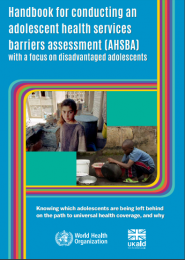Handbook for conducting an adolescent health services barriers assessment (AHSBA) with a focus on disadvantaged adolescents

Review / Resumen:
With the adoption of the Sustainable Development Goals (SDGs) in 2016, the global community recognized universal health coverage as a critical priority. In recent decades, many governments have improved the quality and the coverage of their adolescent health services, but in every country there remain adolescent subpopulations which do not have effective coverage with health services. In keeping with the goals of universal health coverage and a human rights-based approach to health, all adolescents should have a fair opportunity to attain their full health potential, and none should be disadvantaged from attaining this potential (10–12).
A first step towards achieving universal health coverage for adolescents is for each country to assess which adolescent subpopulations do not have effective health service coverage and what the most important barriers are that prevent them from having it. This handbook for conducting an adolescent health services barriers assessment (AHSBA) with a focus on disadvantaged adolescents outlines how governments can assess health service equity and barriers at national and subnational levels in order to identify which adolescents are being left behind, and why.
The handbook’s three objectives are:
-
to build in-country capacity to identify barriers which prevent disadvantaged adolescents from having effective coverage with health services;
-
to trigger remedial action to address the barriers in order to promote high levels of programme performance and more equitable health outcomes among adolescents;
-
to catalyse integration of a focus on who is being left behind and why into ongoing country-level monitoring and evaluation (M&E) of health services for adolescents.
